SYSTEM BOARD
The System Board fits horizontally in the base
of
the System Unit
and has dimensions of approximately 8-1/2 inches by
11
inches. The
System Board
isa
multilayer single land-per-channel design, with
ground and power internal planes provided.
DC
power and a signal
from the power supply enter the board through two six pin connectors.
Other connectors on the board are for attaching the keyboard, audio
cassette, and the speaker. Five 62-pin card edge sockets are also
mounted on the System Board. The system
I/O
channel is bussed
across these
five
I/O
slots.
There are
16
(13 used) Dual In-line Package (DIP) switches mounted
on the card which can be read under program control. These switches
are used to indicate to the system software what options are installed.
They are used to indicate amounts
of
installed storage, both on the
System Board and
in
the System Expansion slots, type
of
display
adapter installed, and desired operation modes upon power-up; ie,
color
or
black and white and 80-or 40 character lines. Switches are also
used to identify when the operating system is to be loaded from
diskette, and how many diskette drives are attached.
The major elements
of
the System Board are divided into
five
major
functional areas. They are, the processor subsystem and its support
elements, the Read-Only Memory (ROM) subsystem, the Read/Write
(RlW)
Memory subsystem, integrated
I/O
adapters, and the
I/O
channel. All functions are described in detail in this section, except for
the
I/O
channel, which has its own section. Figure 2.0 "System Board
Data
Flow" page 2-6, illustrates these functional areas.
The heart
of
the System Board is the Intel 8088 microprocessor.
This processor
is
an 8-bit bus version
of
the 16-bit 8086 processor by
Intel.
It
is
software compatible with the 8086 and, thus, supports 16-bit
operations including multiply and divide. The processor supports 20
bits
of
addressing
(1
megabyte of storage). The processor
is
implemented
in
maximum mode so a co-processor can be added
as
a
feature. The processor is operated at 4.77 Mhz. This frequency
is
derived from a 14.31818 Mhz crystal which
is
divided by three
for.
the
processor clock and by four to obtain the 3.58 Mhz color burst signal
required for color televisions.
At
the 4.77 Mhz clock rate, the 8088 bus cycles are four clocks
of
210 ns or 840 ns.
I/O
cycles take
five
210 ns clocks
or
1.05 microsec
(m sec).
2-3

